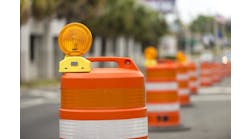The Texas A&M University flagship campus in College Station, Texas, is a living laboratory for transformational transportation technologies and services. A variety of projects are harnessing the brainpower, intellectual creativity, and enthusiasm of researchers, faculty, and students to enhance mobility and safety through more pedestrian, bicycle, transit, and car-share options.
Established in 1871 as the land grant university in Texas, the university has grown from a few buildings and a few hundred students to a campus of 5,200 acres and 64,000 students. Add in another 3,750 faculty and 20,000 staff, and the campus and surrounding communities experience traffic congestion on a regular basis. When 120,000 people fill Kyle Field on football weekends in the fall, the campus becomes the fourth largest downtown in the state.
The transportation network on campus includes 37,000 parking spaces in five garages and some 150 surface lots, and a university-operated bus system runs 70 buses daily, serving 7 million riders annually—a crucial component of campus life. Recent additions include Zipcar, Uber, and Lyft, along with bike-share and dockless bike programs.
The following projects and programs provide examples of recent activities making the campus more bicycle- and pedestrian-friendly. These activities are being undertaken by researchers at the Texas A&M Transportation Institute, faculty and students at Texas A&M University, and Texas A&M University Transportation Services staff, in cooperation with local communities and businesses.
- Autonomous Vehicle Charrette: Students, faculty, staff, researchers, and community representatives were challenged to imagine the future during an autonomous vehicle charrette. Participants discussed four scenarios focusing on different levels of vehicle ownership and automation: privately owned and driver-controlled connected automated vehicles (CAVs), shared driver-controlled CAVs, privately owned autonomous vehicles, and shared autonomous vehicles. The possible impacts on parking, drop-off, and pick-up areas, green space, and development patterns were discussed, along with avoiding potential negative unintended consequences.
-
Bus-based Collision Warning System: One of the campus buses is equipped with the Rosco Mobileye Collision Warning System. This technology alerts the student bus operators to pedestrians and bicyclists that may be coming too close to the vehicles. Analyzing the data generated by the system has helped identify hot spot locations for consideration of design and operational treatments to improve safety.
-
Smart Intersection: A smart intersection automatically alerts pedestrians and bicyclists to turning buses with an announcement “Caution, Bus Turning” in English and Spanish and a lighted supplemental bus sign on the traffic signal pole. The evaluation of the demonstration includes surveys of pedestrians and bicyclists at the intersection, interviews with bus operators, and assessments of the technology.
-
Autonomous Low-speed Shuttle: One-day-long and two-month-long pilots of a NAVYA self-driving shuttle were conducted in 2018 and 2019. Riders surveyed during the pilots indicated positive reactions to traveling in the shuttles and to the shuttles adding a good mobility option on campus.
-
Destination Aggieland App and Aggie Map: The Destination Aggieland smartphone app provides information on travel routes, parking, venue seating locations, and local facilities for visitors and residents. Aggie Map has been expanded to provide real-time information on bus, parking, bicycle, and pedestrian options.
-
Dockless Bike-share: Two dockless bike-share companies have been used on campus. The current provider, VeoRide, has close to 2,500 bicycles on campus and is averaging around 120,000-140,000 rides each month. The development of a web-based dashboard provides origin-destination and route information to help optimize bike locations and repositioning.
-
Dutch Junction and Solar-Energy Enhanced Pavement Markings: A Dutch junction bicycle, pedestrian, and traffic design was implemented on campus. The junction uses bright green pavement markings, which store energy during the day to keep the pathway more visible at night.
These projects and other activities enrich the experience of all students by introducing them to new and varied mobility options. Some students may participate in class activities developing, designing, testing, and evaluating innovative projects, while others may simply experience the new technologies and services on a daily basis. Parents and visitors also encounter the groundbreaking projects, truly making the campus a living laboratory for future transportation innovations.



